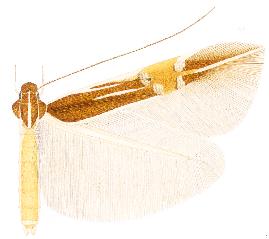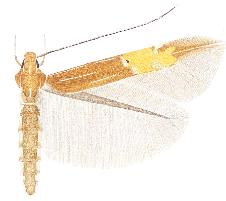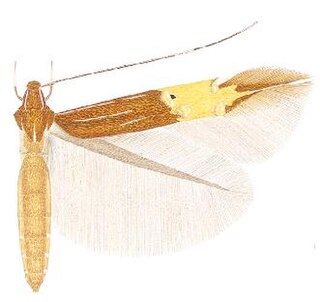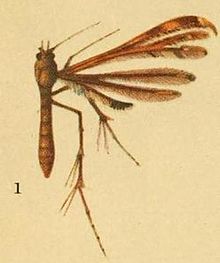Original description
(wingspan male 15 mm) Labial palpi long, semi-erect; second joint slightly dilated apically, light fuscous annulated with darker; third joint rather over half-length of second, smoothly scaled, dark-fuscous. Antennae dark-fuscous, dotted with whitish above. Head and thorax tawny-fuscous. Abdomen long and slender, tawny-fuscous, suffused with dark-fuscous; fourth segment with paler /\ markings, posterior segments margined with whitish. Foreleg dark-fuscous: tibia short, dilated by a tuft of blackish scales banded and tipped with white; tarsus narrowly banded with white at joints. Midleg long, slender, tawny-fuscous: tibia with scale-tufts at 3/5 and apex, the latter tuft emitting a pair of long spurs. Hindleg long and slender, tawny-fuscous, irrorated above with dark-fuscous: tibia with pale scale-tufts at 1/3, 2/3 and apex, second and third tufts each emitting a pair of long slender blackish-tipped spurs; tarsal joints slightly thickened with scales apically. Forewing long, slender, cleft from about 1/2, second segment again cleft from about 2/5 of its length; first segment very narrow, cleft wide and conspicuous; subsegments linear, first subsegment parallel to first segment, divergent from second subsegment: pale tawny-fuscous, suffused with fuscous: base of cleft preceded and edged by a longitudinal blackish discal spot; first segment with central third pale-tawny, cut at 3/4 by a narrow transverse white line, area beyond this pale-tawny; second segment pale-tawny at base of second cleft; subsegments cut at 2/3 of their length by a narrow white line, area beyond this paler. Cilia on costa fuscous-brown, pale-ochreous opposite paler areas, a whitish subapical dot; on hinder-margin of first segment whitish-ochreous mixed with a few whitish hairs and scattered black scales, on third fourth blackish, on outer fourth whitish-ochreous; on fore-margin of second segment pale-ochreous, blackish on central third of segment; on hinder-margin of first subsegment whitish-ochreous with a few scattered black scales; on fore- margin of second subsegmeut whitish-ochreous on first fourth of segment, beyond 1/4 pale-fuscous with a few scattered black scales; on dorsum ochreous-whitish beneath bases of both clefts, otherwise blackish, with minute black scale-tufts at 2/3 and apex. Hindwing cleft from within 1/3 and from near base, segments very slender and linear; dark-fuscous. Cilia dark-fuscous, third segment on both margins with a large black apical scale-tooth and a few scattered black scales between this and base. TYPE Female (No. 41944) in Walsingham Coll., and Co-type (No. 8527) in Bainbrigge Fletcher Coll.; both from Ron, New Guinea, in July 1897 (Doherty). A third example in Lord Walsingham's collection was collected by Doherty at Humboldt Bay, Northern New Guinea, in April 1893.
Xyroptila peltastes is a moth of the family Pterophoridae. It is found in Australia.
Hexadactilia civilis is a moth of the family Pterophoridae. It is found in Queensland, Australia.

Deuterocopus atrapex is a moth of the family Pterophoridae described by Thomas Bainbrigge Fletcher in 1909. It has been recorded from Sri Lanka, Assam, Selangor, the Tenasserim Hills, south-eastern Borneo, Ternate, Ambon Island, Batian, southern Sulawesi, the Sangihe Islands, Halmahera, Neu Pommern, northern New Guinea, the Kei Islands, the D'Entrecasteaux Islands and Queensland.

Deuterocopus honoratus is a moth of the family Pterophoridae. It is found in Queensland, Australia.

Deuterocopus tengstroemi is a moth of the family Pterophoridae. It is known from Java and Queensland, Australia.
Trichoptilus scythrodes is a moth of the family Pterophoridae that can be found in Australia, including New South Wales and South Australia.

Trichoptilus ceramodes is a moth of the family Pterophoridae that is found in Australia, including New South Wales and South Australia.

Sphenarches zanclistes is a moth of the family Pterophoridae that is found in Australia.
Acrocercops tripolis is a moth of the family Gracillariidae. It is known from Indonesia (Java).

Cosmopterix damnosa is a moth of the family Cosmopterigidae. It is known from the United States.

Cosmopterix diaphora is a moth of the family Cosmopterigidae. It is known from the Federal District of Brazil and the states of Guerrero and Veracruz in Mexico.

Cosmopterix erinome is a moth of the family Cosmopterigidae. It is known from the United States.

Cosmopterix pentachorda is a moth of the family Cosmopterigidae. It is known from Ecuador and Peru.

Cosmopterix scirpicola is a moth of the family Cosmopterigidae. It is known from the United States, where found from Maryland and eastern Wyoming to Florida, south-western Louisiana and California. It has also been recorded from Alabama.

Pebobs kale is a moth of the family Cosmopterigidae. It is known from Peru and Trinidad and Tobago.

Pebobs sanctivincenti is a moth of the family Cosmopterigidae. It is known from Grenada and Saint Vincent and the Grenadines.

Pebobs tetragramma is a moth of the family Cosmopterigidae. It is known from Guyana.

Amblyptilia epotis is a moth of the family Pterophoridae. It is endemic to New Zealand and is found in the South and Stewart Islands. It inhabits mountainous terrain covered in alpine vegetation or alternatively alpine wetland habitat. The adults of this species are on the wing from February to March. In appearance the adults of this species are variable in colour however this species can be distinguished from similar species by the oblique apical streak on its forewings as well as the patch of white on the costa cilia towards the apex of the forewing.
Agdistopis sinhala is a moth of the family Macropiratidae. It is found in south-east Asia, including Sri Lanka, India, Japan and Taiwan.

Trachypepla protochlora is a moth of the family Oecophoridae first described by Edward Meyrick in 1883. It is endemic to New Zealand and is found in both the North and South Islands. The preferred habitat of this species is native forest and adults are on the wing from October until February. Adults can be variable in their green shaded colour as well as in the intensity of markings on their forewings. The greenish ground colouration of this moth ensures they are well camouflaged when at rest on green mosses and lichens.
This page is based on this
Wikipedia article Text is available under the
CC BY-SA 4.0 license; additional terms may apply.
Images, videos and audio are available under their respective licenses.









